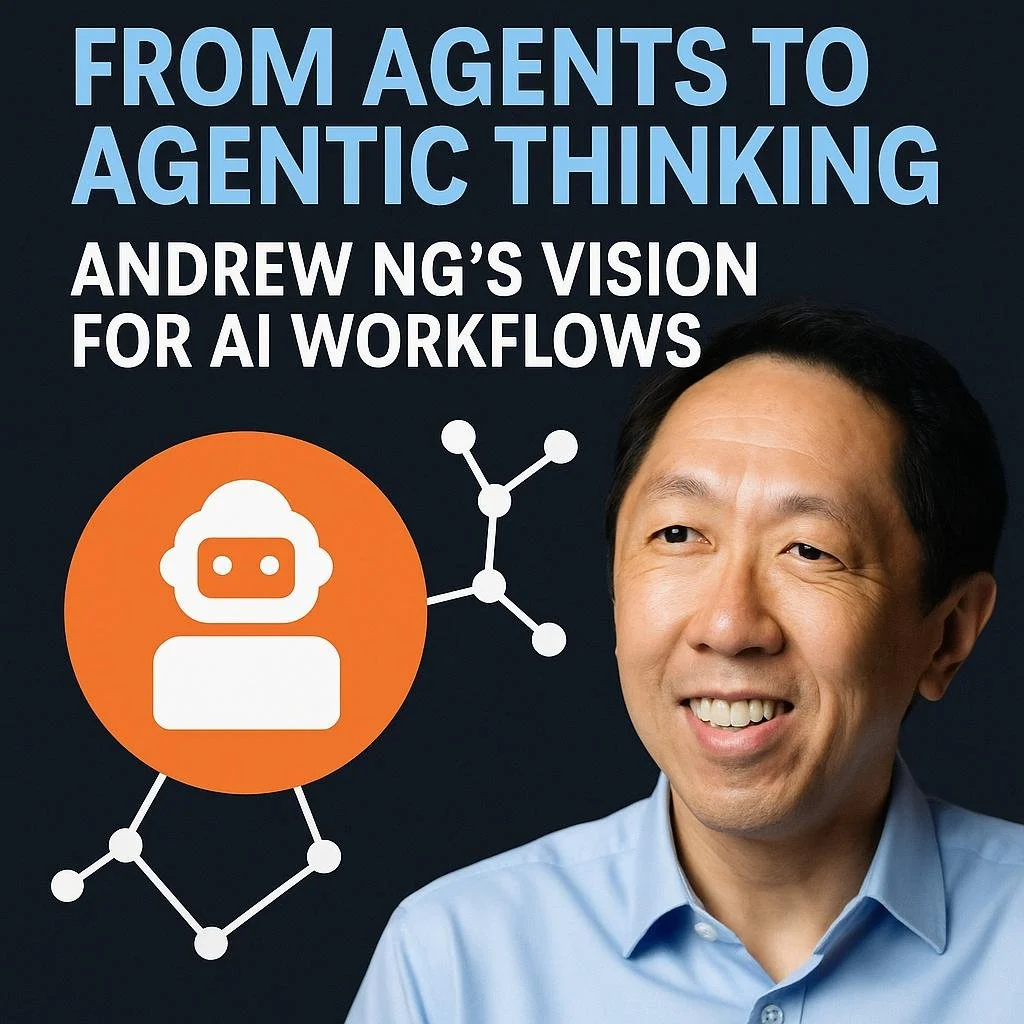From Agents to Agentic Thinking: Andrew Ng’s Vision for AI Workflows
Andrew Ng—legend of machine learning, co-founder of Coursera, and founder of deeplearning.AI—recently shared a fireside chat blending insight, humility, and practical wisdom. From early collaborations with LangChain to today’s evolving AI landscape, Ng offered a masterclass in autonomy, workflow design, tooling, and the practical skills that define success in the AI era.
Rethinking “Agents”: Degrees of Autonomy, Not Definitions
Ng encouraged the community to move past rigid definitions of what counts as an "agent." Instead, he proposed a more productive mindset: evaluate how agentic a system is.
“There are degrees to which something is agentic… Let’s just call all of these things agentic systems with different degrees of autonomy.”
This shift, he believes, helps teams stay focused on building rather than arguing over semantics—and it's a rapidly adopted approach.
Building with the Right Blueprint: Simple Workflows Hold Big Value
While much of the AI world pursues highly autonomous, recursive agents, Ng pointed to the goldmine of opportunity in simpler, semi-structured workflows.
“There’s a lot of simpler workflows that I think are still being built out.”
He described many enterprise use cases as “fairly linear… with very small loops and occasional branches,” emphasizing that smart design doesn’t always demand complexity.
Skills That Matter: Evaluations and Instincts
For teams diving into agentic systems, Ng stressed the importance of breaking down workflows and pinpointing where they falter.
“Putting in place the right eval framework… to trace the individual steps [and] hone in on what’s the one step that is broken.”
He added:
“Most teams are likely too slow to implement systematic evals… it’s still really difficult.”
More experienced teams, he noted, often succeed not because of superior tools, but because they understand when an approach won’t work—and pivot faster.
Tools as Lego Bricks: Master the Full Box
Ng painted a vivid picture of today’s AI tools as colorful Lego bricks. The value, he explained, isn’t in any single brick—but in the ability to combine them creatively.
“The more tools you have is as if you don’t just [have] purple Lego bricks but a red one and a black one and a yellow one and a green one… you can very quickly assemble them into really cool things.”
The takeaway? Learn the bricks, understand their quirks, and practice plugging them together.
Hidden Gems: Voice, Evals, and the AI Stack Few Are Watching
Evals:
Ng recommends starting small—even “awful evals that barely help” can guide iteration. A quick 20-minute setup with five examples and a simple LLM-as-judge loop, he said, is often enough to reduce regression pain.
Voice Stack:
While enterprise interest in voice applications is high, developer attention remains modest.
“The amount of developer attention on voice stack applications... feels much smaller than the large enterprise importance I see.”
Ng emphasized voice’s low friction and how subtle UI tricks—like ambient call center noise—can dramatically improve the user experience.
AI-Assisted Coding:
“I just hate to ever have to code again without AI assistance,” Ng admitted.
He urged companies to move past restrictive coding policies, highlighting the immense productivity gains of AI-powered development.
Everyone Should Code—Even Your Lawyer
Ng extended his advocacy for AI literacy into a bold principle: everyone should learn to code.
At AI Fund, even the receptionist and general counsel write code—not as engineers, but as empowered professionals better able to command their tools.
“They’re not software engineers… but by learning a little bit about how to code [they are] better able to tell a computer what they wanted to do.”
This, he argued, is one of the most meaningful workplace shifts driven by AI.
MCP and the Multi-Agent Frontier
The Model-Controller Protocol (MCP) earned praise as a foundational step toward smarter, more scalable integrations.
“It makes it much easier for agents… to plug into different types of data.”
He highlighted its promise to transform integration effort from n × m to n + m—a key milestone for agent interoperability. Still, MCP is young. Server reliability, authentication, and discovery need refinement.
And agent-to-agent communication?
“Making my agent work with someone else’s agent… it feels like a two miracle requirement.”
We’ll get there, he believes—but we’re not there yet.
The Truth About “Vibe Coding”
Ng didn’t mince words about the hype around “vibe coding.”
“It’s misleading… This is a deeply intellectual exercise.”
Despite LLMs accelerating coding, understanding systems—from Python and JavaScript to browser environments—remains essential. He firmly rejected the idea that coding will become obsolete:
“We’ll look back at some of the worst career advice ever given” in telling people not to learn to code.
Instead, the future belongs to those who can clearly instruct machines—and understand enough to debug when things go wrong.
Startup Secrets from the AI Fund Playbook
When it comes to building successful startups, Ng’s advice is crisp and unambiguous:
Speed:
“The number one predictor of a startup success is speed.”
Technical Mastery:
“The knowledge that’s really rare is how does technology actually work… That’s the most rare resource.”
Business acumen is important, he added, but often easier to acquire than deep technical skill.
Final Thoughts: The Next Chapter Is Being Built—Brick by Brick
As the session came to a close, Ng left the audience not just with insights—but a clear call to action.
Whether it’s building evals, exploring the voice stack, or empowering every employee to code, the roadmap is emerging in real time.
The fireside glow of the conversation left the audience with more than knowledge—it offered direction. And perhaps most importantly, it reminded us that the tools are out there. You just need to reach into the box—and start building.


